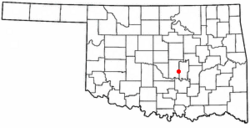Maud, Oklahoma facts for kids
Quick facts for kids
Maud, Oklahoma
|
|
|---|---|

Location of Maud, Oklahoma
|
|
| Country | United States |
| State | Oklahoma |
| Counties | Pottawatomie, Seminole |
| Government | |
| • Type | Aldermanic |
| Area | |
| • Total | 1.05 sq mi (2.72 km2) |
| • Land | 1.05 sq mi (2.72 km2) |
| • Water | 0.00 sq mi (0.00 km2) |
| Elevation | 978 ft (298 m) |
| Population
(2020)
|
|
| • Total | 867 |
| • Density | 826.50/sq mi (318.97/km2) |
| Time zone | UTC-6 (Central (CST)) |
| • Summer (DST) | UTC-5 (CDT) |
| ZIP code |
74854
|
| Area code(s) | 405 |
| FIPS code | 40-46900 |
| GNIS feature ID | 2411050 |
Maud is a small city located in the state of Oklahoma, USA. It sits right on the border between two counties: Pottawatomie and Seminole.
According to the 2020 United States census, 867 people lived in Maud. The city was named after Maud Stearns. She was the sister of the wives of two men who owned the very first general store in the area.
Contents
History of Maud, Oklahoma
This community started around 1890. It was built on the dividing line between what was then Oklahoma Territory and Indian Territory.
Early Days and the Barbed-Wire Fence
In 1890, a long barbed-wire fence was put up. It stretched along the street now called Broadway, from the North Canadian River to the Canadian River. The fence was meant to keep Native Americans out of Oklahoma Territory. However, it did not stop the illegal sale of alcohol to people in Indian Territory.
Growth and Development
Maud got its own post office on April 16, 1896. A few years later, in 1903, the Missouri, Kansas and Texas Railway built a train station here. The first newspaper, called the Maud Monitor, started in 1904. The city officially became a town on July 21, 1905. By 1910, the population was 503 people.
Oil Boom and Population Changes
In the early 1920s, Maud became a "boom town." This happened because oil was found nearby. At its busiest, the population was thought to be around ten thousand people. However, the oil boom did not last long. By the 1930 census, the population had dropped to 4,326.
Geography of Maud
Maud is located at 35°7′55″N 96°46′39″W / 35.13194°N 96.77750°W. This means it is in a specific spot on the map.
Land Area
The United States Census Bureau says that Maud covers about 1.0 square mile (2.72 square kilometers). All of this area is land, with no water.
Population and People
The number of people living in Maud has changed over the years. Here is a quick look at the population counts:
| Historical population | |||
|---|---|---|---|
| Census | Pop. | %± | |
| 1910 | 503 | — | |
| 1920 | 637 | 26.6% | |
| 1930 | 4,326 | 579.1% | |
| 1940 | 2,036 | −52.9% | |
| 1950 | 1,389 | −31.8% | |
| 1960 | 1,137 | −18.1% | |
| 1970 | 1,143 | 0.5% | |
| 1980 | 1,444 | 26.3% | |
| 1990 | 1,204 | −16.6% | |
| 2000 | 1,136 | −5.6% | |
| 2010 | 1,048 | −7.7% | |
| 2020 | 867 | −17.3% | |
| U.S. Decennial Census | |||
Population Details from 2000
In the year 2000, there were 1,136 people living in Maud. There were 435 households, which are groups of people living together. About 301 of these were families.
- About 36.6% of households had children under 18 living with them.
- Most households (51.3%) were married couples living together.
- About 15.4% of households had someone living alone who was 65 years or older.
The average household had 2.52 people. The average family had 3.07 people.
Age and Income
In 2000, the population was spread out by age:
- 28.1% were under 18 years old.
- 17.0% were 65 years or older.
The average age in Maud was 36 years.
As of the 2020 census, the average income for a household in Maud was $46,500. For families, the average income was $50,000. About 71.9% of residents owned their homes.
Education in Maud
Students in Maud attend schools that are part of the Maud Public Schools district.
Notable People from Maud
Maud has been home to some interesting people:
- Edmond Harjo: He was the last surviving Seminole Code Talker from World War II. He received the Congressional Gold Medal in 2013. He lived near Maud for most of his life.
- Wanda Jackson: She is a famous rockabilly singer, often called the "Queen of Rockabilly." A street in Maud, Wanda Jackson Boulevard, is named after her.
See also

- In Spanish: Maud (Oklahoma) para niños

